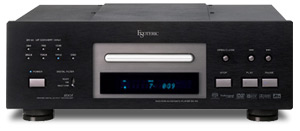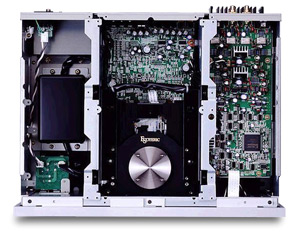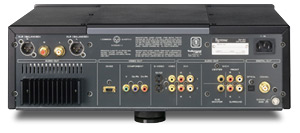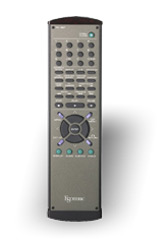![[SoundStage!]](../titles/sslogo3.gif) Home
Audio Home
Audio Equipment Review |
||||||||||||||||||||||
With the introduction of SACD and DVD-A, audiophiles simultaneously began to anticipate the improvement in sound the two high-rez formats could bring and lament the fact that they may need more than one player to spin the two formats and their existing CDs. Enter the universal audio/video player, a new component that acts like a Swiss Army knife, playing any disc you throw at it, including DVD videos. Many such players have been announced, but for whatever reason, a number of them have been delayed. Add to this the fact that in some early players DSD was converted to PCM and the momentum the two high-rez formats could have due to an all-in-one player has been slowed -- again. For all of these reasons, Esoteric's DV-50 is a much-anticipated component. It's not only able to play anything you can insert safely in its tray, it's available now. And even better yet, SACDs are handled by a built-in DSD filter, so they're not converted to PCM. Yes, you pay for such flexibility done right, $5500 USD, but the DV-50's features only start here. TEAC, Esoteric's parent company, is a true consumer-electronics giant. Highly diversified in its product offerings, its three product badges -- TEAC, Esoteric, and Tascam -- span just about every category of audio electronics: digital and analog, consumer and professional. Esoteric is TEAC's high-end brand and is well known in Asia especially. If you think you've seen every assault on the state of the art in digital playback, you may be surprised by Esoteric's D-70/P-70 DAC/transport combination, the brochure of which is better reading than a good many audio magazines. The DV-50 is the first Esoteric digital product to play more than CDs and is TEAC's first universal audio/video player. Its 17 3/8"W x 6 3/16"H x 14"D size makes it seem especially large when compared to products from competitors, but its weight -- 46 pounds -- lets you know that it's not just a big empty box. A fair amount of the weight comes from what TEAC calls the Ultra High Density chassis, which includes heavy top and bottom plates to increase stability. Internally, the DV-50 is divided into three compartments: the fully shielded transformer on the left, the transport mechanism and video circuits in the center, and the audio circuits on the right. The mechanism is not one of TEAC's patented VRDS transports, but it does make use of a TEAC-designed "aperture stabilizer," which sits atop the platter and helps the mechanism remain stable as it changes speeds. It also clamps the disc magnetically to the platter. The total weight of this stabilizing mass is 17 1/2 ounces. One external feature is worth noting: The DV-50's machined feet ingeniously place the player on downward-pointing spikes and integral protection discs, but with no fumbling or seating required. Very neat.
On the front panel are the bare minimum of operating controls along with two rows of Up Convert LEDs that indicate the sampling frequency at which the DV-50 is playing or if the DSD filter is in use for SACD playback. The DV-50 can upsample CDs, 24/96 DVD-Vs, and DVD-As, and exactly how it does this is governed by the custom filter configuration you choose. Below the rows of LEDs is a three-position switch for choosing between RDOT and FIR filters or both combined. TEAC describes these filters only in sparse fashion in the DV-50's 55-page manual. I will mention that the DV-50 can upsample to 1536kHz, and I will comment on the sonic effect of the filters below.
The DV-50's button-packed remote is hefty and easy to use. I especially like that it includes the ability to open the DV-50's drawer and dim the LED display or turn it off completely. Another feature on the remote is the ability to turn off the DV-50's video circuitry for the ultimate in audio purity. The DV-50 also has a CD-direct mode that bypasses all other circuitry when a CD is playing, but this must be enabled via the player's onscreen menus.
System I used the Esoteric DV-50 initially in my reference system, which consists of Wilson Audio WATT/Puppy 7 speakers, Lamm ML2 amplifiers, and Lamm L2 Reference preamp. Interconnects and speaker cables were from Shunyata Research (Aries and Andromeda), MIT (Oracle v2.1), or Stereovox (SEI-600 and LSP-600). All power cords were from Shunyata Research (Taipan and Anaconda Vx), as was power conditioning (Hydra with Anaconda Vx power cord). I also used Sound Application's XE-12S power-conditioner with a 20A Elrod power cord. To make comparisons between the DV-50's balanced and single-ended outputs as well as hear it in another context, I also used the player in my second system: Magnepan MG1.6/QR speakers and Mark Levinson No.383 integrated amp. Cables here were Analysis Plus Solo Crystal Oval, with Shunyata power cords and Hydra power conditioner again in use. For CD comparison, I had on hand a Mark Levinson No.390S CD player as well as the mighty Zanden Model 5000 Mk III DAC, which I used with a Mark Levinson No.37 transport. For SACD comparison, I used a budget-priced Sony DVP-NS500V DVD/SACD player. Having it all The best thing about using a player like the Esoteric DV-50 is that the software format means nothing to it. You put a disc in and music comes out. Throughout the time I used the DV-50, it never failed to play a disc -- including many CD-Rs. The initial read time was slower than with either of the CD rigs I used, but it wasn't nearly as long as the Sony SCD-1's. Because the DV-50 can play back so many types of discs, evaluating its performance becomes a multi-faceted endeavor. The obvious place to start is with CDs, however, because at this point we all have many more of them than any other type of software. Here the DV-50 is slightly on the euphonic side of the fence, reminding me broadly of the sound of the Bel Canto DAC2, a very fine digital-to-analog converter. Perhaps it's no coincidence that both are able to upsample. With the DV-50, CDs are always easy on the ears, never displaying the sort of upper-midrange/lower-treble harshness that plagued early digital; but this doesn't come at the expense of openness or overall resolution. Doreen Smith's A Tribute to Julie London [Fidelio FACD006] is a rather laid-back recording whose spaciousness can be lost if a system or digital component is so friendly sounding as to be muddy. Not so with the DV-50, which reproduces this disc with its sense of the recording venue completely intact. The DV-50's leading-edge definition sounds just about perfect to my ears, which is to say that it's neither prominent nor recessed in terms of everything else the player does sonically. This may be why the DV-50 sounds the way it does: relaxed and yet able to convey whatever music your CDs have in their pits.
From the treble and through the midrange, CD playback with the DV-50 displays notable detail, albeit in a touch gentler fashion than with the Mark Levinson No.390S. This is due to the sonic refinement of the DV-50, not some quirky combination of peaks and valleys in the player's frequency response. My test for this is Greg Brown, whose voice can be overly chesty or not chesty enough when a digital component is not quite right. Among his recordings, my favorite is Further In [Red House Records RHR CD 88], and with the DV-50 it sounds characteristically lush, with Brown's voice just as it should be: full but not bloated. "Juuuust right," my notes say. The DV-50's bass is excellent overall, easily able to convey the weight and slam of CDs like Harry Connick's She [Columbia CK 64376]. I note a very, very slight prominence in the upper bass, which gives CDs a touch of added warmth. But I will take this over lean, bleached sound any day. With SACDs, the DV-50 kicks it up a notch, as Emeril would say. Here, as with the best-sounding DVD-As and 24/96 DVD-Vs, the DV-50 produced the best digital sound I've heard in my system. The main difference occurs in the high frequencies, which seem to extend out further and trail off in a more realistic fashion, remaining present and delicate at the same time. For the most part, SACD and the other high-resolution formats do the little things better than CD. I don't hear wholesale betterment up and down the frequency spectrum, but rather get a more musically complete and natural rendering of each recording. I hear more of what I perceive as the recording itself, not the hardware used to reproduce it. A good example of this is the Police's Ghost in the Machine [A&M 069 493 605-2], which sounds distant and murky on CD. The same is true of the SACD, but inner detail is more abundant as is the ability to hear into the recording. This is true to an even greater extent with the Isaak Hayes classic Hot Buttered Soul [Mobile Fidelity UDSACD 2005]. It's spooky how much more of this recording you can hear on SACD. But the DV-50's performance is not just a matter of format -- it's a cut above that of other DVD and SACD players I've heard. Old favorites like Steve Earle's Guitar Town [MCA 088 113 055-2] sound anew -- certainly more detailed but also more poised, less digital-like. Classical music especially takes on a sense of grandeur that is addicting, even for someone like me who has a novice's tastes. I singled out the DVD-A recordings on the Nishimura label in my editorial this month because as a group they sound superb, which can't be said for all DVD-As. Organ New Dimensions [Nishimura PIAC-1002] is a little less forward than the many Telarc organ CDs I own, and the organ sounds drier, more like the pipe organs I've heard live, especially in large churches with lots of wood and marble. The recording is tremendously spacious and room-filling no matter the system on which I played it, and when the lowest notes show up you'll feel them if you play the disc at realistic levels and your system is up to the challenge. As I outlined above, there are a couple of choices you have to make in terms of using the DV-50. First is the position of the digital-filter switch. To my ears, the best sound was with the RDOT setting, which according to TEAC, re-creates sounds above 20kHz by using "principles to generate musical information likely to occur between data samples." The DV-50's manual describes RDOT as having "a slow roll-off and natural extended audio characteristics." FIR and RDOT+FIR add a small bit of lower-midrange and bass thickness that didn't suit the overall character of the DV-50. Second, TEAC rightly recommends using the DV-50 from its balanced outputs because of the unit's fully balanced circuitry. With both the Mark Levinson No.39 and No.390S CD players, I found that balanced use was very worthwhile sonically, and the same thing is true with the DV-50, although not to same extent. There certainly is more delineation and air in the DV-50's performance when it is used balanced, but using the player through its single-ended outputs is not a gigantic concession. You will still get wonderful sound from this player no matter how you connect it to your audio system. Comparisons Once you start comparing digital source components as accomplished as the Esoteric DV-50, Mark Levinson No.390S ($6700), and Zanden Model 5000 Mk III/Mark Levinson No.37 combo (roughly $15,000), you realize that digital has come a very long way sonically since its inception and that the differences among the very best digital components are small in an absolute sense. Just the same, there are differences, and some digital front-ends sound better than others. The No.390S, which plays only CDs but will decode 24/96 software, is the most overtly neutral-sounding of the three, and it has the best bass too. It is also an ergonomic treat, with its heavy remote and built-in volume control. The Zanden combo is the best-sounding CD playback I've heard because it does everything to an exceedingly high level, never ceding much in any way. It offers truth and beauty in abundance, and in the end it's a joy to listen to. The DV-50 costs less than either of these options (far less than the Zanden/Levinson combo) but offers playback options that neither can. With CDs, its sound is an amalgam of the No.390S and Zanden/No.37 rig: easy on the ears but still detailed. Playing SACDs and DVDs, however, it betters the sound of either rig, although very good CDs like JVC's XRCDs can certainly rival even the best SACDs. Perhaps the best of all digital worlds is to have the DV-50 with an outboard DAC like the Zanden used with a preamp like the Audio Research Reference Two Mk II or Mark Levinson No.32, both of which have balanced and single-ended inputs. This sort of setup is not for the weak of wallet, however. Because of its flexibility, performance, and cost, the Esoteric DV-50 proves to be a very good buy even at its $5500 price. The future is here If you've waited longingly for a universal A/V player that offers true high-end sound, the DV-50 is for you. It's always enjoyable to listen to, and when you push its capabilities with SACDs and DVD-As, it will stun you with the sound it can produce. Its build quality is better than that of most components double its cost, and its rich feature set allows it to be equally at home in a two-channel system and a home-theater rig. And it's way cool to just plunk a disc into its drawer and watch the player sort out playback for you. "Here you go, Mr. Mickelson -- 16/44, 24/192 or DSD coming riiiight up." But perhaps most intriguing is the cost for all of the DV-50's proficiency. While $5500 ain't peanuts, the DV-50 can take the place of separate CD, SACD, and DVD players and thus simplify your A/V lifestyle. Yes, you can find CD playback especially that will outperform the DV-50 in this way or that, but the cost will be prohibitive, and you won't be able to play all of the other discs that the DV-50 can. And while other companies have announced that similar high-end players will be on the market soon, they're not here yet, and their prices are even more steep. Audiophiles rejoice -- your wait is over. The Esoteric DV-50 is a jack of all digital trades that does a masterful job with them all. ...Marc Mickelson
|
||||||||||||||||||||||
|
||||||||||||||||||||||
![[SoundStage!]](../titles/sslogo3.gif) All
Contents All
ContentsCopyright © 2003 SoundStage! All Rights Reserved |


 The DV-50 uses
Burr-Brown PCM1738 24-bit/192kHz DACs in a fully balanced dual-differential configuration.
These DACs can convert linear PCM up to 24 bits and a 192kHz sampling rate, but not DSD.
However they do have a DSD decoder interface for SACD playback, which TEAC uses in the
DV-50. According to TEAC, the DV-50's circuit boards are laid out for performance, not
build convenience, and use "high-end" passive parts.
The DV-50 uses
Burr-Brown PCM1738 24-bit/192kHz DACs in a fully balanced dual-differential configuration.
These DACs can convert linear PCM up to 24 bits and a 192kHz sampling rate, but not DSD.
However they do have a DSD decoder interface for SACD playback, which TEAC uses in the
DV-50. According to TEAC, the DV-50's circuit boards are laid out for performance, not
build convenience, and use "high-end" passive parts.  Around back are
stereo RCA and XLR outputs, the latter of which TEAC recommends because of the DV-50's
balanced circuitry. The player's multichannel outputs are completely separate from the
two-channel outputs (and of less substantial quality too), which gives me the idea that
TEAC meant the DV-50 to be a serious two-channel source that could also do multichannel,
not the other way around. The progressive-scan DV-50 can do video via composite, S-video,
and component outs, and output 24/96 digital data from coax and TosLink connections. An
IEC power-cord receptacle, grounding lug, and heatsink for the audio section round out the
rear-panel amenities.
Around back are
stereo RCA and XLR outputs, the latter of which TEAC recommends because of the DV-50's
balanced circuitry. The player's multichannel outputs are completely separate from the
two-channel outputs (and of less substantial quality too), which gives me the idea that
TEAC meant the DV-50 to be a serious two-channel source that could also do multichannel,
not the other way around. The progressive-scan DV-50 can do video via composite, S-video,
and component outs, and output 24/96 digital data from coax and TosLink connections. An
IEC power-cord receptacle, grounding lug, and heatsink for the audio section round out the
rear-panel amenities. In describing the
features of this player, I've only scratched the surface and talked about those pertinent
to two-channel audio playback. Suffice it to say that the DV-50 can be the centerpiece of
a multichannel audio/video system as well as a source component for a two-channel rig. In
fact, it's meant to be both.
In describing the
features of this player, I've only scratched the surface and talked about those pertinent
to two-channel audio playback. Suffice it to say that the DV-50 can be the centerpiece of
a multichannel audio/video system as well as a source component for a two-channel rig. In
fact, it's meant to be both.